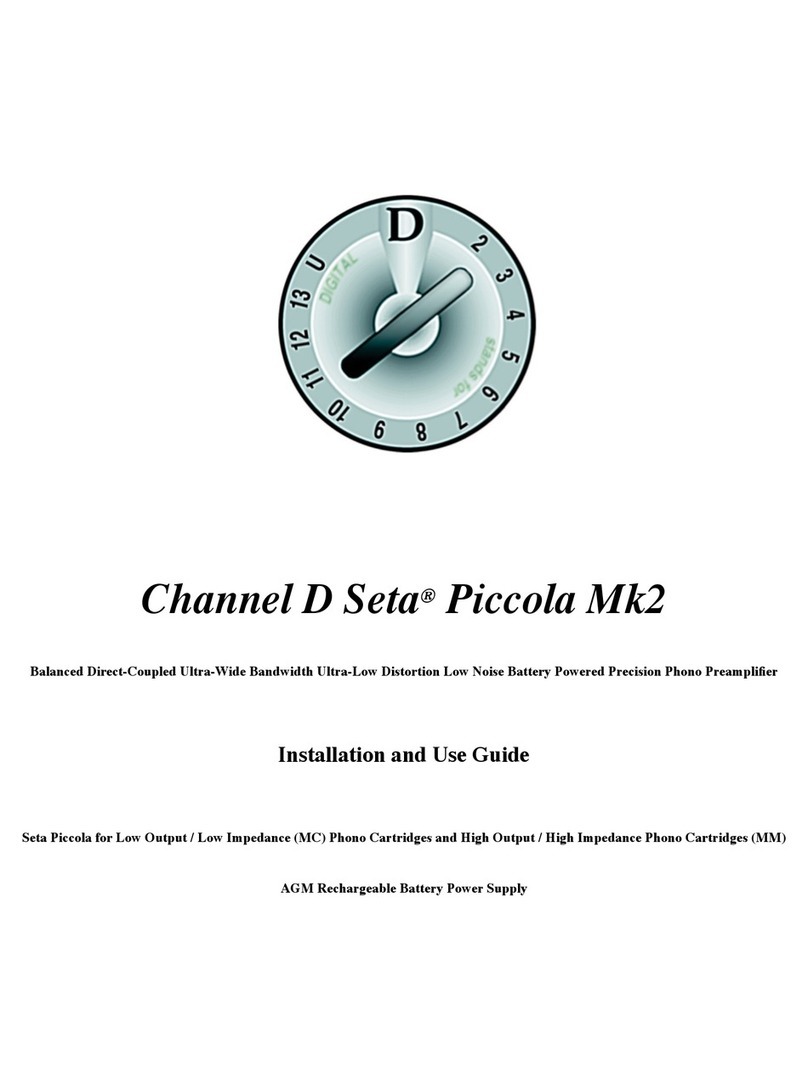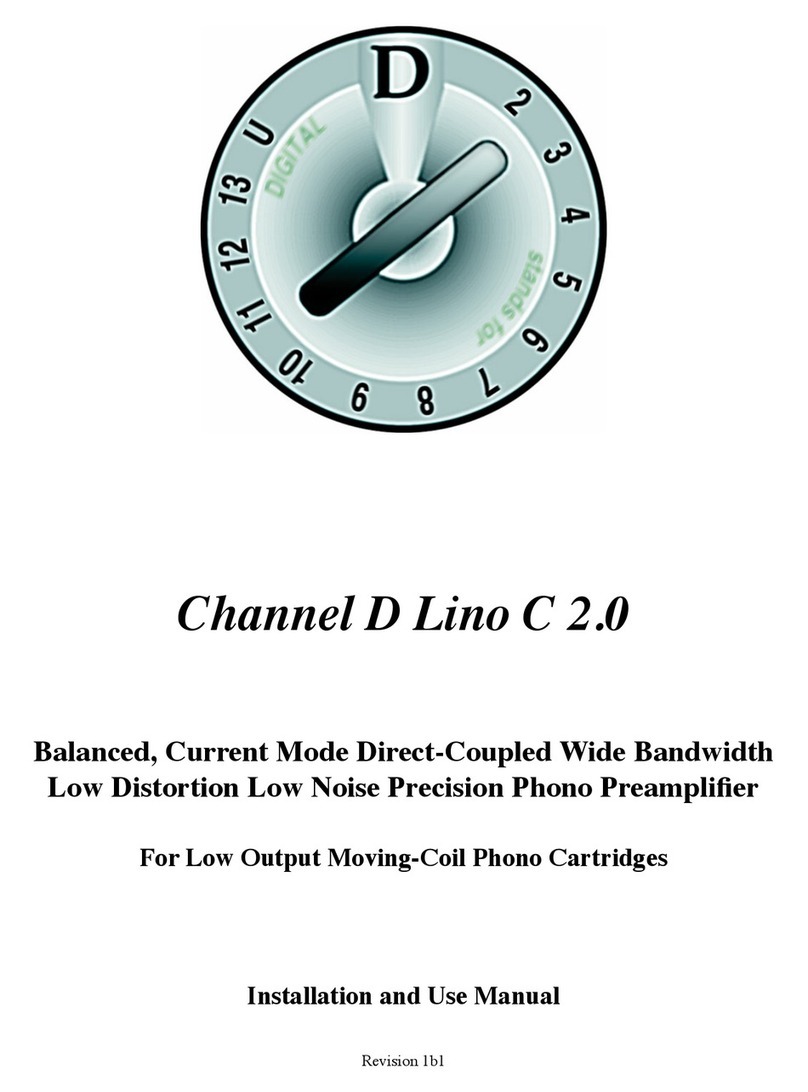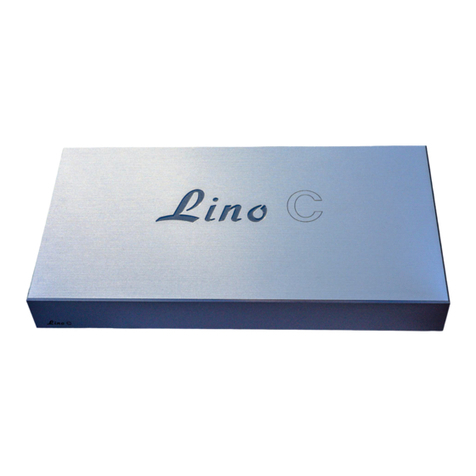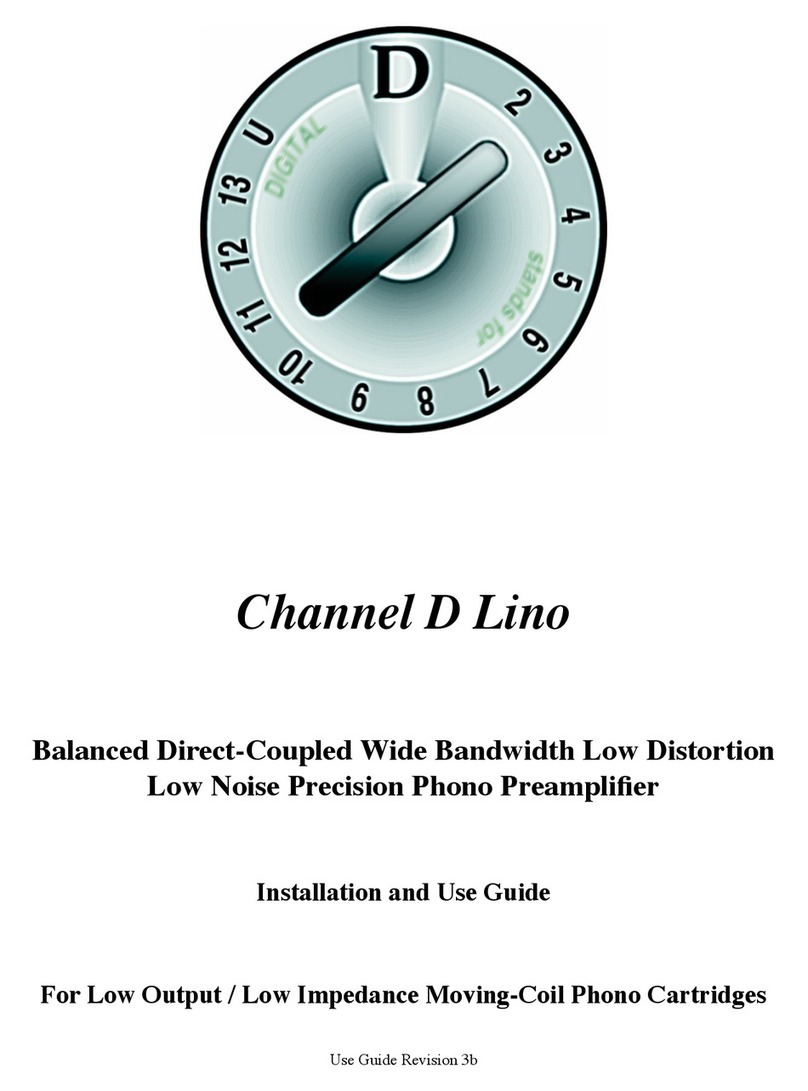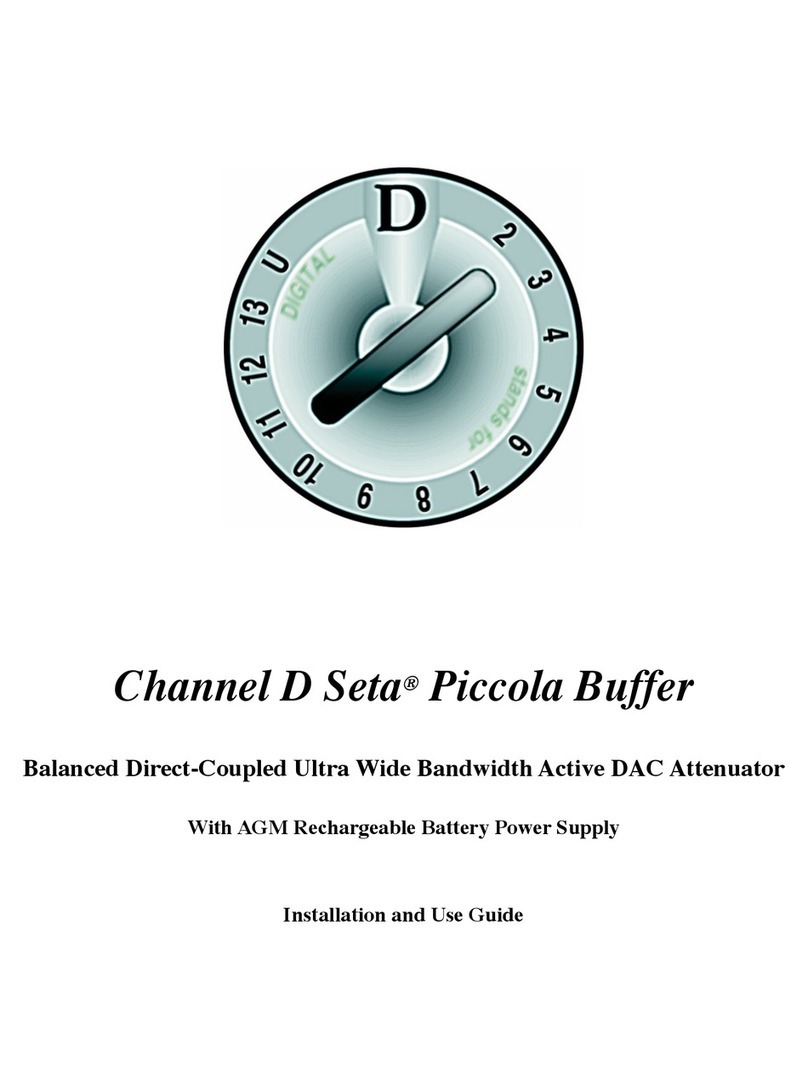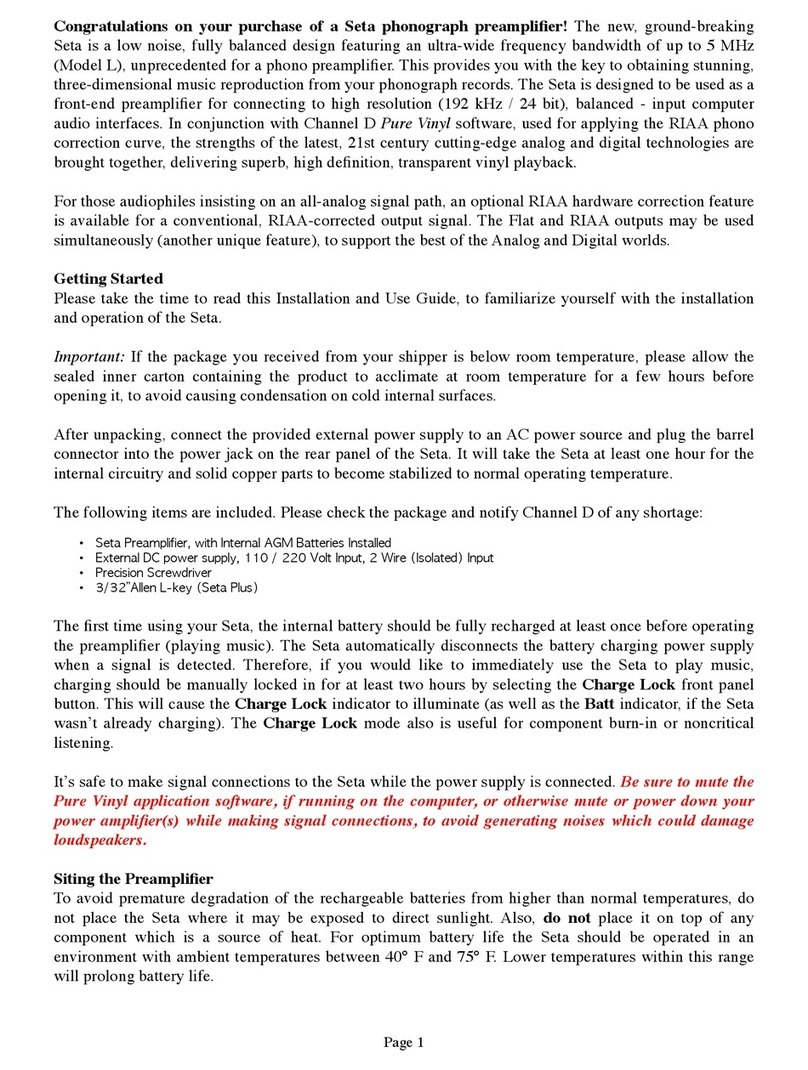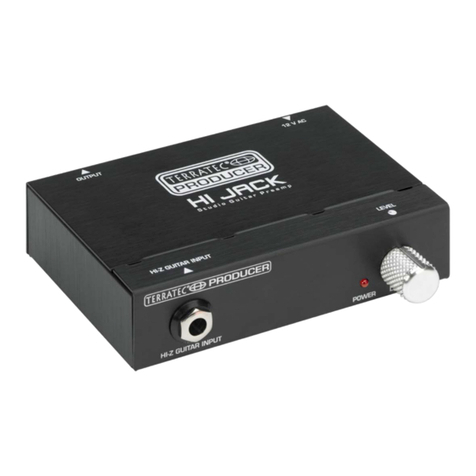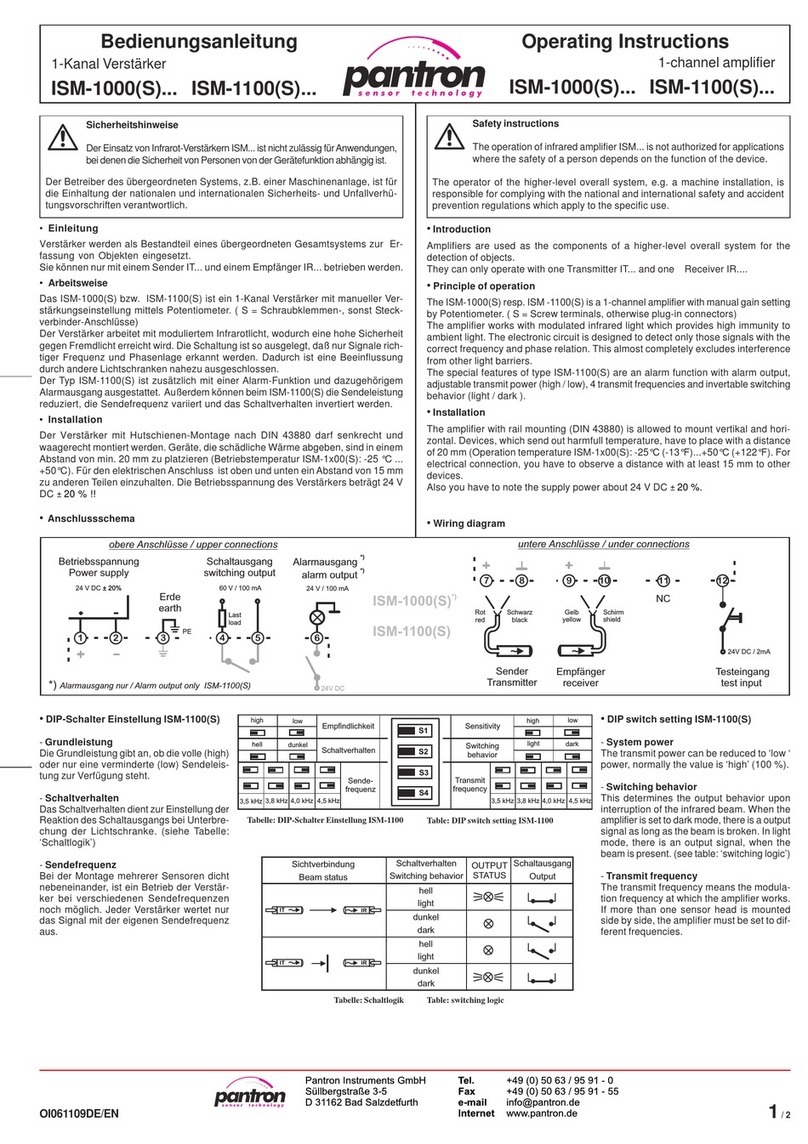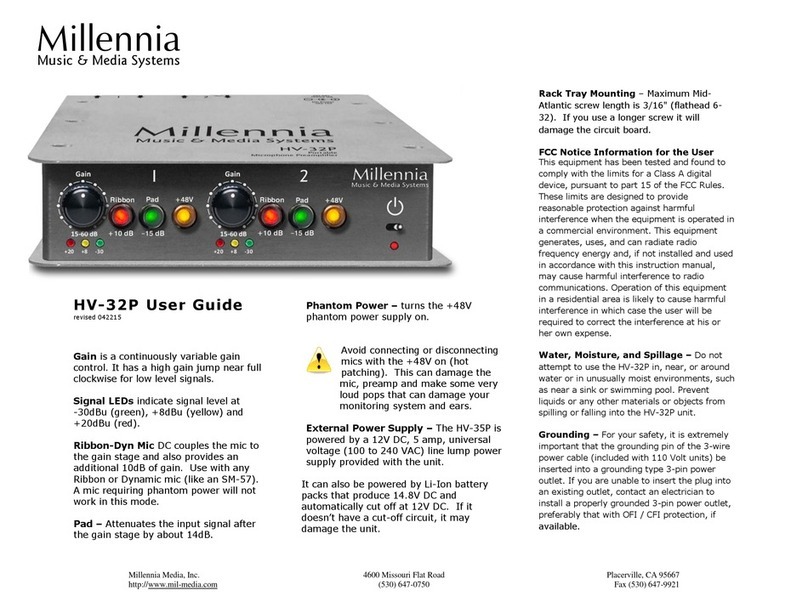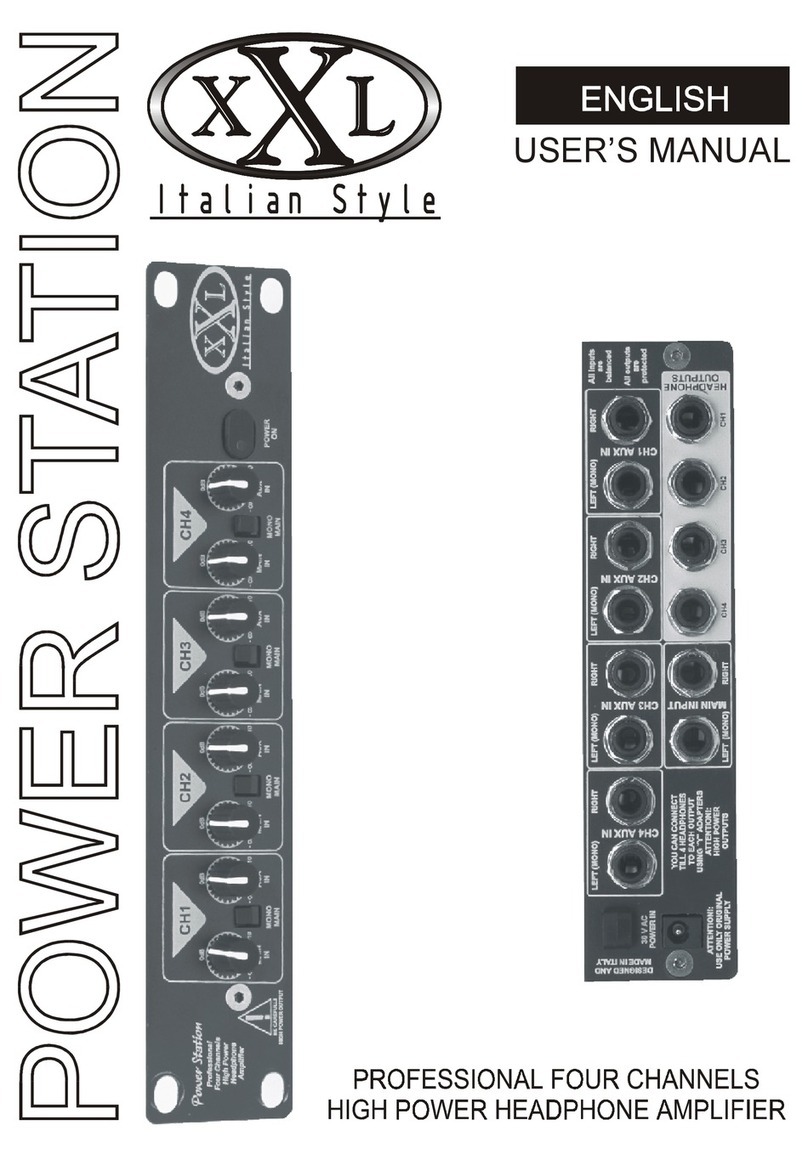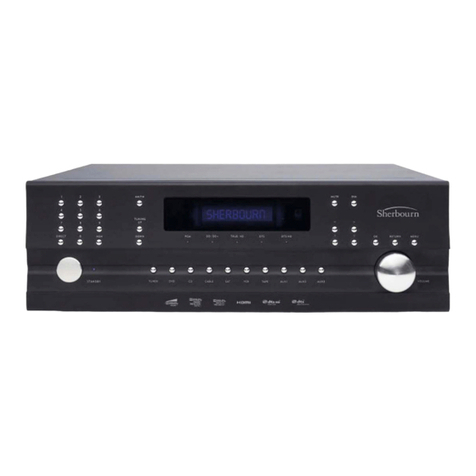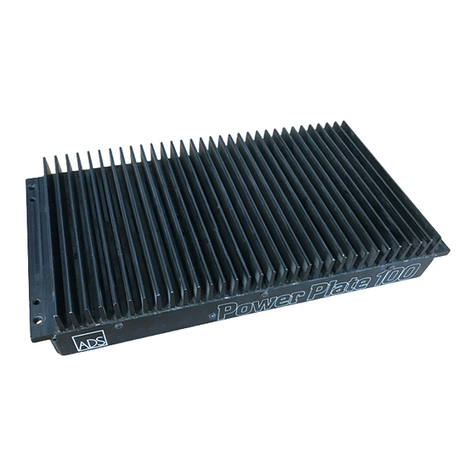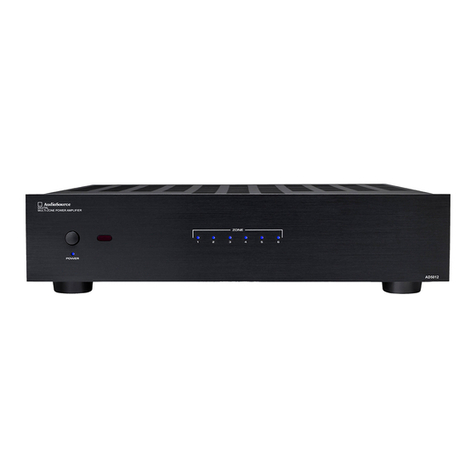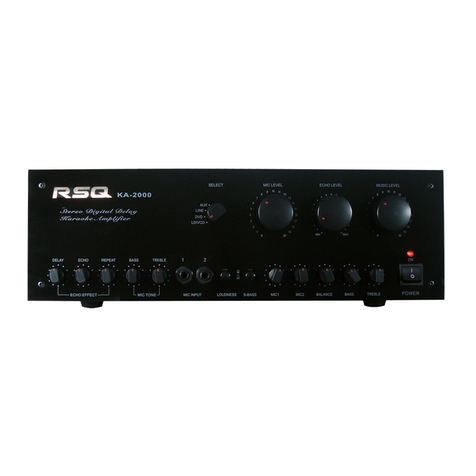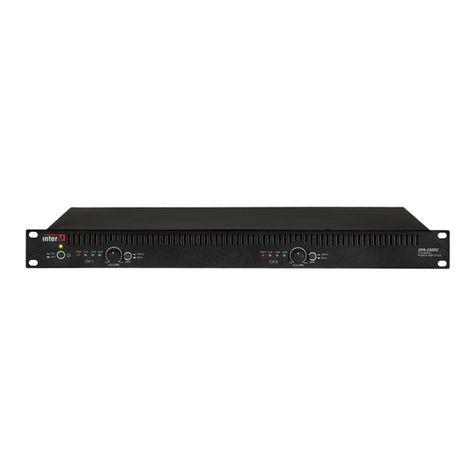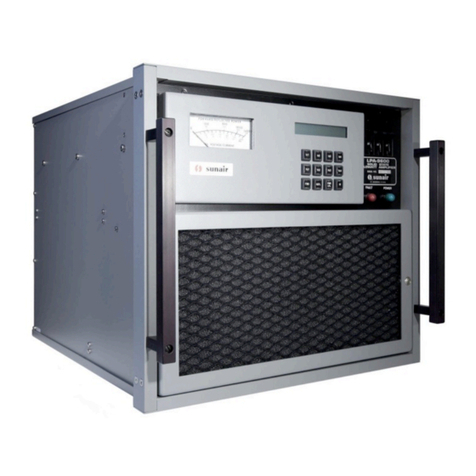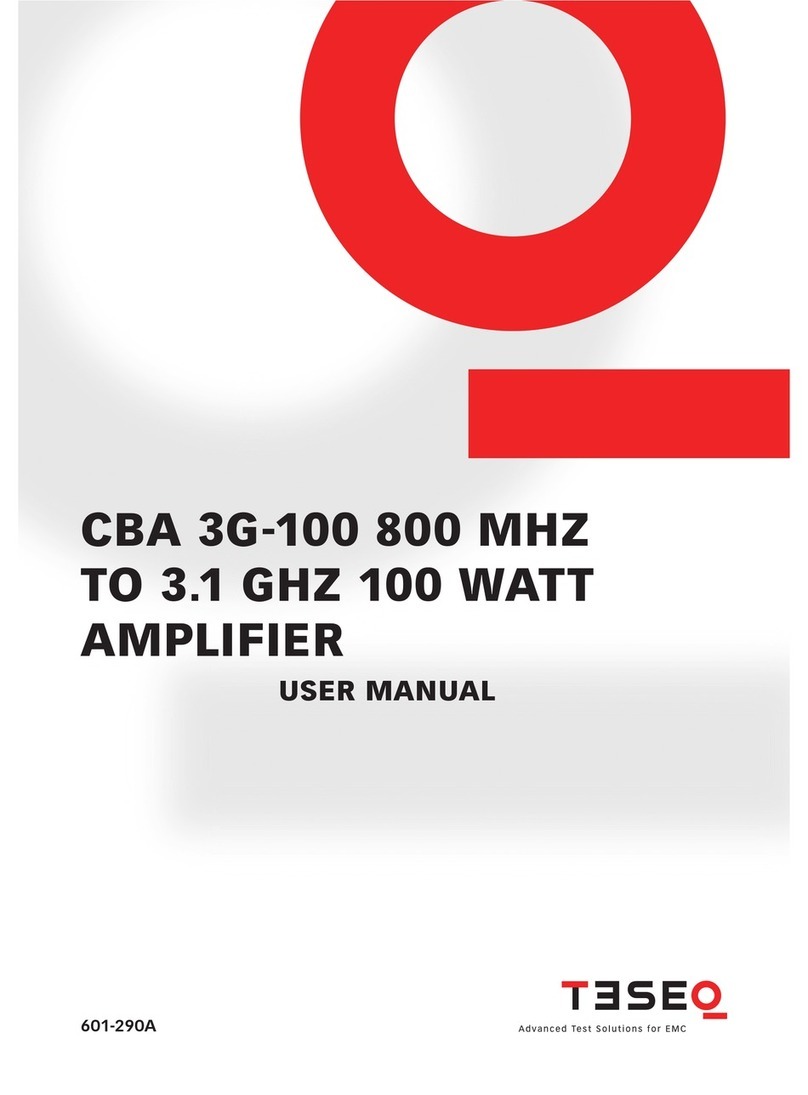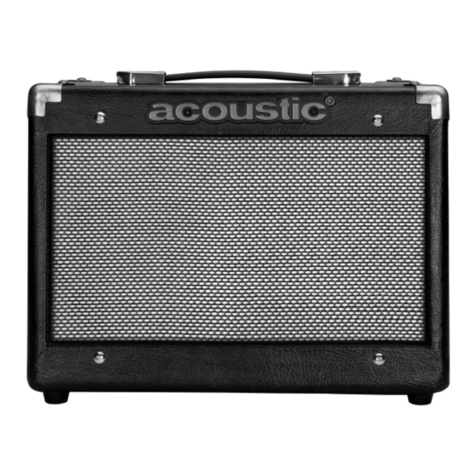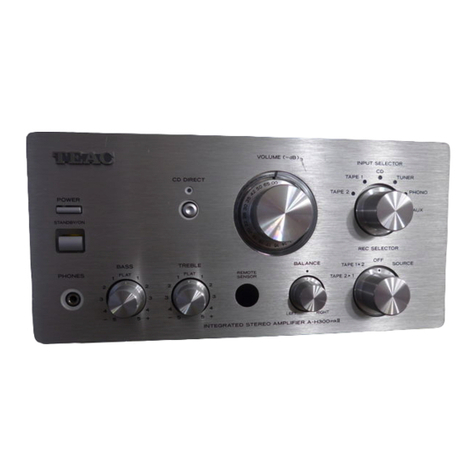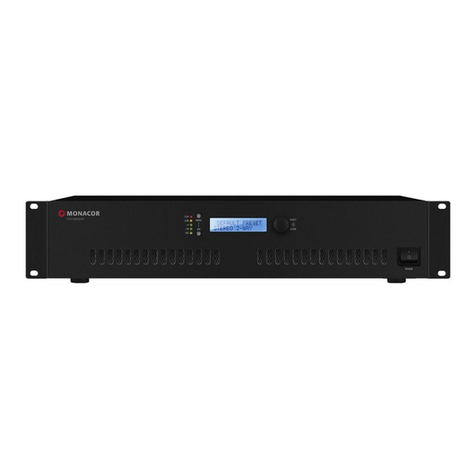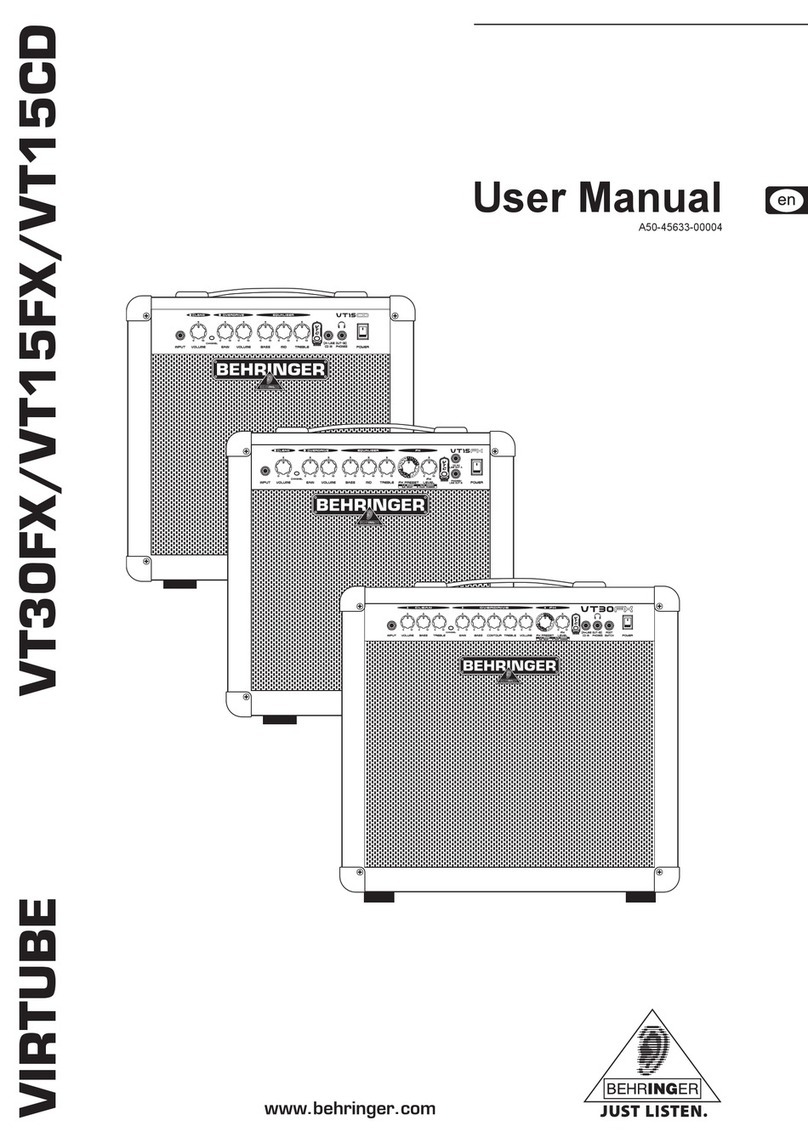Channel D Seta Nano Operating manual

Channel D Seta™Nano
Balanced Direct-Coupled Ultra Wide Bandwidth Phono Preamplifier
Installation and Use Guide
Seta Nano for Low Output, Low Impedance Phono Cartridges

Page 1
Installation and Use Guide
Seta Nano for Low Output, Low Impedance Phono Cartridges
Document Revision 1f
Channel D • Trenton, New Jersey • (609) 393-3600
email: [email protected]
web: http://www.virtual-vinyl.com
Contents Copyright © 2008, 2009, 2010 Channel D All Rights Reserved

Page 1
Page 2
Congratulations on your purchase of a Seta phonograph preamplifier! The new, ground-breaking
Seta Nano is an ultra low noise, fully balanced design also featuring an ultra wide frequency bandwidth of
DC to 3 MHz (-3 dB). This provides you with the key to obtaining stunning, three-dimensional music
reproduction from your phonograph records.
The Seta is designed to be used as a front-end preamplifier for connecting to high resolution (192 kHz /
24 bit), balanced - input computer audio interfaces. In conjunction with Channel D Pure Vinyl software,
used for applying the RIAA phono correction curve, the strengths of the latest, 21st century cutting-edge
analog and digital technologies are brought together, delivering superb, high definition, transparent vinyl
playback.
For those audiophiles insisting on an all-analog signal path, the RCA output connectors of the Seta Nano
provide a conventional, RIAA-corrected output signal. The Flat and RIAA outputs may be used
simultaneously (another, unique feature, unprecedented for a phonograph preamplifier), to support the
best of the Analog and Digital worlds.
Getting Started
Please take the time to carefully read this Installation and Use Guide, to familiarize yourself with the
installation and operation of the Seta.
Important: If the package you received from your shipper is below room temperature, please allow the
sealed inner carton containing the product to acclimate at room temperature for a few hours before
opening it, to avoid causing condensation on cold internal surfaces.
The following items are included. Please check the package and notify Channel D of any shortage:
• Seta Nano Preamplifier
• External 15 Volt DC power adapter
• Slotted Screwdriver for Loading and Trim Adjustment
• Metric hex key for 3 mm chassis fasteners
Signal connections should be made to the Seta Nano only while the power supply is disconnected. A
Low Output type cartridge (less than 0.9 mV) having an internal resistance of 50 ohms or less must
be connected for proper operation.
(1, 2) Signal Inputs
(1) The RCA inputs may be used with conventional shielded cable (single-ended) phono connections.
They also serve as single-ended to balanced adapters (provided that the turntable ground connection is
isolated). Consult the section of this Installation Guide concerning the proper configuration of the internal
single ended / balanced jumpers. The factory setting is with the jumpers set for balanced operation.
(2) XLR inputs are intended for use with balanced (shielded twisted pair) turntable connections. For
optimum, low noise operation this is the preferred type of connection. Balanced wiring provides better
noise immunity than conventional shielded (single conductor plus shield) cable.
(3, 4) Signal Outputs
(3) The balanced XLR outputs provide a signal without RIAA correction (“Flat”), and are intended to be
connected to the balanced inputs of a high quality audio interface (ADC), for use with Channel D’s Pure
Vinyl software (for Macintosh computers) for applying RIAA compensation (or other similar software on
other computer platforms). (Consult the Pure Vinyl software User Guide for more information.)

Page 1
Page 2
Page 3
(4) The single ended (RCA) outputs may be connected to the input of a conventional line stage preampli-
fier, or to the single-ended input of a computer audio interface (ADC) if a balanced input isn’t available.
Depending on the setting of the RIAA Enable Switch (7), the signal at the RCA outputs will be either
“Flat” or RIAA corrected (for monitoring without using a Mac computer and Channel D Pure Vinyl
software). With the switch in the “in” (engaged) position, the RIAA corrected signal will be output.
CAUTION: To avoid sending loud transient signals to your loudspeakers, be sure to mute or reduce the
volume of the loudspeaker amplifier to minimum before changing the setting of the RIAA Enable
Switch. The internal DC servo is affected by the switch setting, and takes at least 1 minute to stabilize.
The Seta Nano can be configured internally to also direct the RIAA corrected signal to the preamplifier’s balanced
outputs. This capability was incorporated for audiophiles wishing to use the balanced outputs of the Seta primarily (or
exclusively) for all-analog music listening via a balanced line stage or passive attenuator. However, in this configuration,
the output signal will be either Flat or RIAA corrected, as determined by the RIAA Enable Switch setting, not both
simultaneously. If you would like to enable this option, contact Channel D Support for additional information.
(2)
(1)
(3)
(4)
(5)
(6)
(8)
(7)
(9)
(5) Power
Connect the barrel connector of the supplied power adapter to the 15 volt power input jack. Signal
connections should be made to the Seta Nano only while the power supply is disconnected.
(6) Chassis Ground (Optional Connection)
Securely connect the chassis ground wire from your turntable or tonearm to the grounding post on the rear
panel of the Seta.

Page 2
Page 3
Page 4
(7) RIAA Enable Switch
See (4), single ended outputs, for the description of the function of this switch.
(8) TRIM Control
The Seta rear panel features a unique, precision trim control for adjusting the inter-channel cartridge
loudness balance. The range of the control is 2 dB. The neutral position is with the slot of the brass
actuator oriented vertically, as shown in the figure above. Clockwise rotation of the control slightly
increases the right channel gain while slightly decreasing the left channel gain, and vice versa.
To properly adjust the cartridge balance, use the supplied small slotted screwdriver while playing a
monophonic record (or a record with the music mixed to the center). Observe the RIAA Balance indicator
in the Pure Vinyl application, and adjust the trim control until the value is close to zero (within ± 0.1 dB is
sufficient). This adjustment should only need to be performed once, and can be left alone, unless or until a
new cartridge is later fitted to your turntable.
(9) Cartridge Loading
Use the supplied slotted screwdriver to adjust the load to the desired value for each input channel (with
detents at 1k/500/200/150/100/50/25 ohms). The Seta Nano uses low noise, gold contact rotary switches,
accessible from the rear panel, in conjunction with precision, surface mount metal film resistors, for the
shortest possible signal path.
Accessing Internal Jumper Settings (Optional)
For added flexibility of operation, internal gold-fingered jumpers are provided to configure the operation
of the Seta Nano. The factory default settings of these jumpers will deliver the optimum performance.
However, technically advanced users may wish to configure the Seta Nano for specific applications.
To access the internal configuration jumpers, remove the four 3 mm stainless steel hex head fasteners at
the corners of the bottom of the enclosure, as indicated in the figure below. Then, carefully turn the unit
over, and remove the top portion of the enclosure. (This operation is best performed with a soft cloth or
towel covering the work surface, to avoid scratching or marring the enclosure.)

Page 3
Page 4
Page 5
When reassembling the enclosure, take care to insure that the four fastener holes in the bottom are aligned
with the four threaded brass bushings in the enclosure shell, before reinstalling the fasteners. With the unit
upside down, gently place the preamplifier chassis onto the enclosure shell and guide it into place. There
is a small lip, running around the inside circumference of the shell, that supports the bottom plate. Be sure
that the bottom plate rests on top of this lip (as shown in the illustration below), not inside it; otherwise,
the fasteners will not properly align with the bushings.
Enclosure Shell
Lip
Chassis
Jumper Settings
Single Ended / Balanced Operation
Two internal, gold contact jumpers (marked on the circuit board as S.E.) are used to configure the Seta for
single ended or balanced operation. In single ended operation, the “negative” cartridge terminals are
connected to circuit common. This connection may be used if hum is detected, and the connecting cable
from the turntable is a shielded type coaxial RCA cable (a single shielded conductor). See the photo
illustrating the jumper location (S.E.). The single ended setting is the jumper “bridging” position. Both
jumpers must be configured the same way for proper operation. For balanced operation, place the jumpers
in the “Parking” position (one jumper pin open), or remove them.
S.E. Right Channel
S.E. Left Channel (Rev 0)
(Rev 1 or later)
DC / 10 Hz
Neumann
TEST
The Seta Nano will function noiselessly (no detectable hum) even in single ended mode with
most tonearm / turntable setups, including those with the tonearm “ground” connected to the
cartridge (such as Rega tonearms), using the RCA input connectors. However, for optimum

Page 4
Page 5
Page 6
low-noise operation, it is strongly advised that balanced (shielded twisted pair) cable be used
to connect the turntable to the Seta. This may entail rewiring the turntable. For low impedance
(low output cartridges, such as moving coil, with an internal resistance of 100 ohms or less,
and nominal output voltage around 0.8 mV or less) shielded twisted pair microphone or audio
signal cable can be used.
The shield should be connected to the XLR connector pin 1; positive cartridge connection to
pin 2, and negative to pin 3. For more information, see the Pure Vinyl User Guide.
Take care to confirm that your turntable / tonearm / cartridge doesn’t connect the chassis
ground or common to any of the cartridge signal leads. This may cause a detectable hum,
particularly when configured for balanced inputs. An example of this is Rega tonearms. Here,
the internal circuit connector has the chassis ground connected to the left channel negative
signal lead. To correct the problem, the tonearm output connector must be carefully disassem-
bled and the negative signal lead disconnected from the chassis ground connection. The
tonearm ground then should be provided with a separate connection to attach to the Seta
external grounding lug, or connected to the shield (XLR Pin 1) if using balanced cables.
Another example includes cartridges having a connection or lug that connects the cartridge
housing to one of the signal leads (usually the left channel “negative” lead). This should be
disconnected or removed by gently bending or tugging with fine tip pliers or other such tool.
Neumann RIAA Curve Modification
The two internal jumpers labelled NEUMANN, if removed, will create an extra shelving characteristic in
the RIAA curve, with a turnover frequency of 50 kHz (+3 dB), to compensate for the putative roll-off
introduced in the vinyl mastering process by the cutting lathe. The factory setting is for standard RIAA
(with the jumpers bridging the NEUMANN contacts).
High-Pass Filter
As configured from the factory, the RIAA correction circuit incorporates a 12 dB / octave (2nd order), 10
Hz (-0.6 dB at 20 Hz) high-pass (“rumble”) filter. This filter may be bypassed by moving the four
jumpers, indicated in the previous photograph, from the “inner,” 10 Hz position to the “outer,” direct-
coupled (DC) position, as labelled on the circuit board. See diagram below for clarification. Be certain
that all four jumpers are correctly installed before reconnecting the preamplifier.
DC
10 Hz
Four jumpers
placed in
“inner”
positions
Four jumpers
placed in
“outer”
positions
The DC setting should be used with caution, as the unfiltered, extremely low frequency signals from the
turntable are capable of causing amplifier clipping, excessive amplifier power use, low frequency noise,
excessive loudspeaker (woofer) excursion, and loudspeaker damage.
TEST Mode
The internal jumpers labelled TEST, if removed, disable the high frequency (passive) part of the RIAA
correction, to enable testing and verification of the full bandwidth of the low frequency (active) gain stage
used in the RIAA correction circuit. These jumpers are for factory use only, and should be left as installed.

Page 5
Page 6
Specifications - Seta Nano for Low Output (0.8 mV or less), Low Impedance Cartridges
•Voltage Gain: 46 dB, “Flat” Outputs; 58 dB, RIAA Compensated Outputs
•Input Load Resistance: Maximum 2 kΩ; real panel selector for 25/50/100/150/200/500/1k ohms
•Input Capacitance: 130 pF
•Frequency Response (-3 dB): DC to 3 MHz (measured using XLR inputs)
•Phase Shift: ultralinear, less than 1 degree, DC to 100 kHz
•Distortion: less than 0.02%, 20 Hz - 20 kHz, 0 dBV (ca. 3 volts, balanced, peak to peak) output level
•RIAA Correction Topology: Symmetrical, Fully Balanced with Passive HF, Active LF; hand selected, ultra
low dissipation sprayed metal contact polypropylene film capacitors
•RIAA Correction Curve Accuracy: Better than ±0.1 dB, 20 Hz - 20 kHz (with high pass filter disabled)
•RIAA Correction Channel Match: Better than ±0.02 dB, 20 Hz - 20 kHz
•RIAA Overload Margin: ≥ 15 dB, 20 Hz - 20 kHz
•RIAA High Pass Filter: Balanced, 12 dB / octave, 10 Hz cutoff frequency (-0.6 dB at 20 Hz)
•Circuit Topology: Symmetrical, Fully balanced, direct-coupled (no capacitors in signal path, except for the
RIAA correction); second order DC servo, with primary time constant of 10.3 seconds; low noise 4-
layer circuit boards and surface mount component technology
•Channel Separation: ≥ 80 dB, 20 Hz - 20 kHz
•Cartridge Fine Balance Trim: 2 dB range
•Inputs: Neutrik, Premium Gold Pin XLR Balanced; RCA (RCA inputs also function as single-ended to
balanced adapters)
•Outputs: Neutrik, Premium Gold Pin XLR Balanced; RCA (single ended)
•Output Impedance: less than 40 ohms
•Output Drive Capability: Balanced cable, up to 33 feet (10 meters), 600 ohms or greater load impedance
•Power Supply: Quadruple filtered, low noise, galvanically isolated internal DC converter; ultra low ESR filter
capacitors; external Energy Star approved high efficiency 15 volt DC power adaptor, 110 VAC input (a
110/220 VAC 50/60 Hz universal supply also is available)
•Power Consumption: less than 5 watts
Dimensions
• 6” x 2” x 6” (W x H x D)
• Weight 3 pounds
Warranty
• One year parts and labor, limited warranty. In the unlikely event your Seta must be returned to Channel D
for repair, contact Channel D in advance for a return material authorization number and shipping
instructions.
In keeping with our continuing efforts to enhance and improve our products, we reserve the right to change
specifications without notice.
Contents Copyright © 2008, 2009, 2010 Channel D All Rights Reserved
Table of contents
Other Channel D Amplifier manuals
